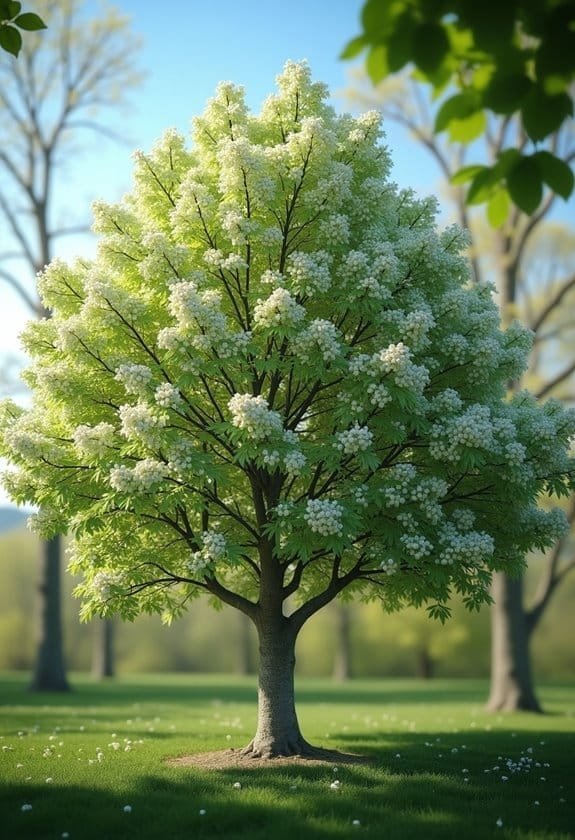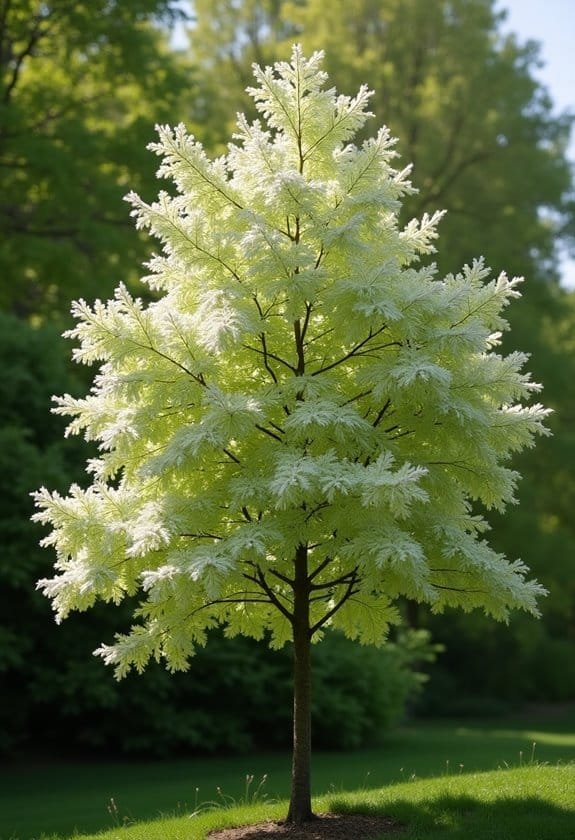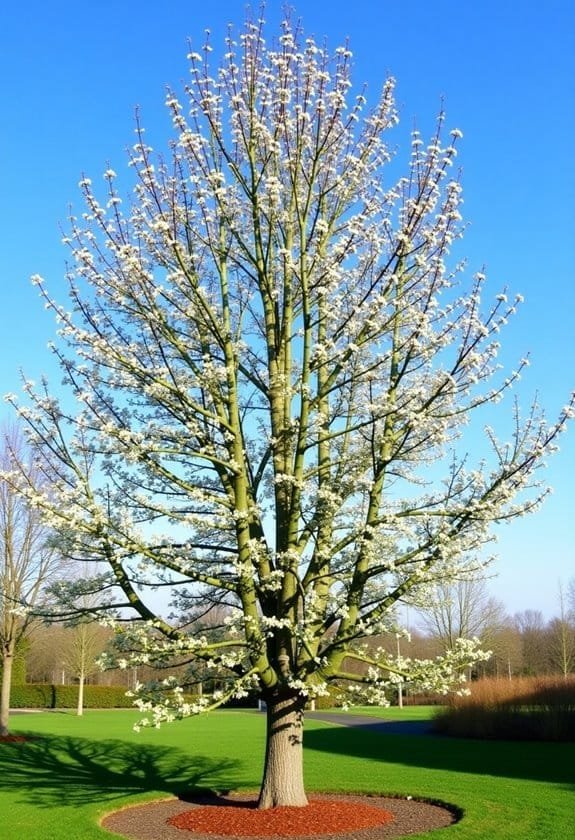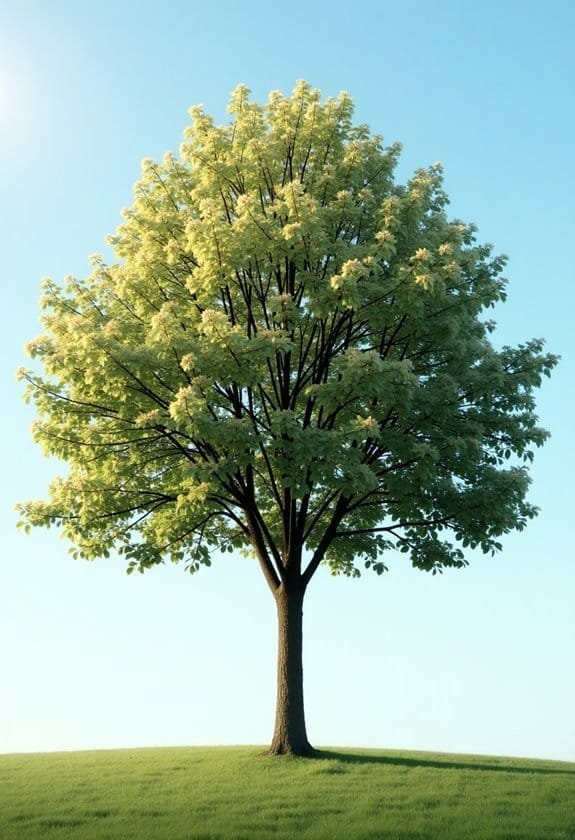Sorbus aria, commonly known as the Whitebeam, is a medium-sized deciduous tree reaching heights of 15 meters with distinctive silvery-grey bark and a symmetrical, domed crown. It's prized for its thick oval leaves featuring white-felted undersides, which create a striking visual contrast throughout the growing season. In May, the tree produces clusters of creamy-white flowers that attract pollinators, followed by bright scarlet berries in autumn that provide food for native birds. Well-suited for urban and residential landscapes, this hardy species thrives in well-drained, limestone-rich soils and offers year-round aesthetic appeal. The Whitebeam's unique characteristics and ecological benefits make it an intriguing specimen for closer examination.
Main Points
- Sorbus aria is a deciduous broadleaf tree native to southern England, growing up to 15 meters with a distinctive domed crown.
- The tree features oval leaves with white-felted undersides, smooth grey bark, and produces white flowers in May followed by scarlet berries.
- Whitebeam requires well-drained, limestone or chalk-based soils and thrives in full sun to partial shade conditions.
- The tree attracts pollinators with its spring flowers and provides food for birds through its autumn berries.
- Regular pruning in late winter and consistent watering during establishment are essential for healthy growth and development.
Introduction

Sorbus aria, commonly known as the Whitebeam, stands as a distinctive deciduous tree native to the landscapes of southern England.
This graceful species, reaching heights of up to 15 meters, features an elegant domed crown, smooth grey bark, and characteristically thick oval leaves with white-felted undersides.
The Whitebeam's ecological significance shines through its May-blooming white flowers and nutritious fall berries, which support local wildlife while adding ornamental value to both natural and cultivated settings.
Common Name
Commonly known as Whitebeam, this deciduous broadleaf tree stands out for its distinctive light-colored wood and bark, which inspired its English name. The common name reflects both the tree's physical characteristics and its historical significance in British landscapes, where it has been cultivated for centuries as an ornamental species.
In horticultural circles, Whitebeam's nomenclature proves particularly apt when the tree displays its seasonal transformations throughout the year. During May, clusters of delicate white flowers appear, creating a striking contrast against the tree's silvery-green foliage, while autumn brings forth abundant scarlet berries, known locally as chess apples. These visual elements contribute to the tree's dual identity as both a practical and decorative specimen.
The name "Whitebeam" has become deeply ingrained in British botanical tradition, particularly in southern England where the species naturally occurs. Its straightforward descriptive name helps distinguish it from other members of the Sorbus genus, making it easily recognizable to both amateur gardeners and professional horticulturists who value its compact, domed shape and modest mature height of 15 meters.
Scientific Name
The scientific classification places this species firmly within the Rosaceae family as Sorbus aria, a taxonomic designation that reflects its relationship to other rose family members. Throughout botanical history, this species has been known by several synonyms, including Pyrus edulis Willd. and Sorbus edulis, demonstrating the evolving understanding of its classification.
The species' placement within the broader Aria genus connects it to related taxa such as Aria nivea and Aria alpina, highlighting its position in a complex network of botanical relationships. The specific epithet "aria" derives from Latin, meaning "air," which aptly describes the tree's characteristic appearance with its broad, light-catching foliage and open crown structure.
Beyond its taxonomic significance, Sorbus aria's scientific classification underscores its ecological value within native ecosystems, where it contributes to biodiversity and habitat creation.
The species' scientific designation helps researchers and conservationists track its distribution, study its genetics, and understand its role in various ecological communities, making it an important subject for both academic study and practical conservation efforts.
Overview
Among Europe's most distinctive trees, the Whitebeam (Sorbus aria) stands out for its striking appearance and ecological importance. This remarkable deciduous tree, reaching heights of up to 15 meters, has become a cherished presence in southern England's natural landscape, where it thrives in sunny locations with well-drained soil.
The Whitebeam's most distinguishing features are its thick, oval leaves, which create a mesmerizing contrast between their dark green upper surface and white, downy underside. During May, the tree bursts into life with clusters of cream-white flowers that attract various pollinating insects, contributing considerably to local biodiversity.
As the seasons progress, these blossoms transform into vibrant scarlet fruits known as chess apples, which serve a dual purpose in the ecosystem. While these berries become edible for humans when nearly decomposed, they primarily function as a crucial food source for native bird species.
The Whitebeam's adaptability to urban environments, combined with its aesthetic appeal and ecological value, makes it an excellent choice for parks, gardens, and civic landscaping projects.
Key Features
The Whitebeam stands as a striking deciduous tree, reaching heights of up to 15 meters with a naturally compact, domed crown.
Its distinctive oval leaves showcase irregular serrated margins and possess a remarkable white, downy underside that creates an enchanting silvery effect when stirred by the wind.
The tree bursts into bloom during May, presenting abundant clusters of cream-white, five-petalled flowers that later transform into vibrant scarlet berries, known locally as chess apples.
Growth Size
Commonly reaching heights of up to 15 meters (49 feet), Sorbus aria presents itself as a medium-sized tree with a distinctive compact, domed crown. The tree's well-proportioned structure makes it an excellent specimen for parks and gardens, where its architectural form can be fully appreciated throughout the seasons.
The Whitebeam's growth pattern contributes greatly to its ornamental value, developing a symmetrical canopy that maintains its appealing shape with minimal maintenance. Its robust branches support thick, dark green leaves that showcase a striking white underside, creating a dynamic display when caught in the breeze.
During May, the tree's mature size provides an impressive platform for clusters of cream-white flowers that emerge across the crown.
As the tree develops, it maintains its characteristic domed silhouette while establishing a strong vertical presence in the landscape. This controlled growth habit, combined with its moderate mature size, makes the Whitebeam particularly suitable for larger residential gardens and urban green spaces where space might be at a premium but visual impact is desired.
Appearance
With its distinctive silvery-grey bark and symmetrical domed crown, Sorbus aria stands out as an elegant specimen in any landscape. The smooth, grey bark creates a refined aesthetic that complements the tree's naturally balanced form, while its compact shape makes it particularly suitable for formal gardens and urban settings.
The tree's most striking features emerge throughout the growing season, beginning with its thick, oval-shaped leaves that display irregularly toothed margins. These leaves are eaten by various insects and showcase a remarkable contrast between their dark green upper surface and the densely hairy, whitish underside.
In May, clusters of creamy-white, five-petalled flowers emerge, creating a spectacular display as they're pollinated by a diverse array of insects. As autumn approaches, the flowers give way to bright scarlet berries, which gradually develop their characteristic russet colour. These berries, known traditionally as chess apples, transform the tree's appearance while providing essential sustenance for local bird populations.
The combination of grey bark, distinctive foliage, and seasonal color changes makes the Whitebeam a visually dynamic addition to any landscape throughout the year.
Flowering Season
During May, Sorbus aria bursts into spectacular bloom, producing dense clusters of cream-white flowers that measure 8 mm across and form corymbs spanning 5-7.5 cm in diameter.
These delicate blossoms transform the tree into a beacon for local wildlife, particularly beneficial insects seeking nectar-rich resources during the flowering season.
The Royal Horticultural Society recognizes this species for its remarkable hermaphroditic flowers, which contain both male and female reproductive structures within each bloom.
This unique characteristic enables efficient pollination, as the flowers are primarily pollinated by insects, especially industrious bees that navigate between the cream-white clusters.
The synchronized flowering of Sorbus aria creates a crucial ecological window, supporting local pollinator populations during the critical spring period.
As summer shifts to autumn, these ephemeral flowers give way to striking scarlet berries, completing the tree's annual reproductive cycle.
This progression from flower to fruit exemplifies the species' ecological significance, providing sustenance for various wildlife species throughout different seasons while contributing to the broader biodiversity of its habitat.
Growing Requirements

Sorbus aria flourishes in conditions that combine full sun to partial shade with well-drained, moisture-retentive soils rich in limestone or chalk.
The tree's adaptability to USDA Zone 5 temperatures makes it a resilient choice for European gardens, where it can withstand both winter chills and moderate summer heat.
While establishing its impressive 15-meter dome-shaped canopy, this species requires consistent moisture and benefits from regular mulching to maintain ideal soil conditions, though it becomes more drought-tolerant once mature.
Light
For ideal growth and development, whitebeam trees thrive in full sun to partial shade conditions. These hardy trees, whose berries are sometimes known as chess apples, require a minimum of six hours of direct sunlight daily to maintain their distinctive silvery-white leaves, which are covered in felt-like hair on their undersides.
The foliage provides an excellent habitat for various moth species, whose caterpillars are frequently seen feeding on the leaves during spring months.
Light exposure plays an essential role in the whitebeam's flowering and fruiting capacity, directly influencing its ability to produce abundant clusters of white blossoms and later, the characteristic orange-red berries.
While these trees can tolerate partial shade, positioning them in locations with maximum sunlight exposure enhances their growth potential and increases their ornamental value in the landscape.
The relationship between adequate light and soil moisture is particularly significant, as proper illumination helps regulate water uptake and prevents issues associated with oversaturated soil conditions.
In urban settings, careful consideration of building shadows and surrounding vegetation is vital when selecting planting locations to guarantee optimal light requirements are met.
Soil
Well-drained soil forms the foundation of a thriving whitebeam tree's growth, with this species showing particular affinity for limestone and chalk-based environments.
The soil composition plays an essential role in the tree's development, requiring a balance between moisture retention and efficient drainage to prevent waterlogging and subsequent root problems.
While Sorbus aria demonstrates remarkable adaptability across various soil types throughout its European range, peak growth occurs in environments where the soil pH ranges from neutral to slightly alkaline.
The tree's root system responds particularly well to these conditions, much like a well-orchestrated dance between the plant's needs and its growing medium.
Proper soil drainage stands as a non-negotiable requirement, acting as a safeguard against root rot and other moisture-related complications that could compromise the tree's health.
Gardeners should assess their soil composition carefully, making necessary amendments to guarantee adequate drainage while maintaining sufficient moisture levels for sustained growth.
In situations where native soil conditions prove less than ideal, incorporating organic matter and guaranteeing proper drainage through soil improvements can help create an environment where whitebeam will flourish.
Water
Beyond soil composition, proper watering practices shape the success of Sorbus aria cultivation. The species demonstrates a remarkable balance between moisture requirements and water conservation strategies, requiring consistent hydration while maintaining adaptability to various conditions.
Young specimens particularly benefit from regular irrigation methods during their formative years, ensuring robust root development and steady growth.
While established trees exhibit notable drought tolerance techniques, they shouldn't be left completely without supplemental watering during extended dry periods. The implementation of effective irrigation methods, such as deep watering at less frequent intervals, encourages deeper root growth and enhances the tree's natural resilience.
Mulching around the base serves as an excellent water conservation strategy, helping maintain soil moisture levels while reducing evaporation.
During periods of drought stress, Sorbus aria displays admirable adaptability, though it's crucial to monitor moisture levels carefully, particularly in chalky soils that may drain more rapidly.
A balanced approach to watering, combining regular observation with timely irrigation, supports the tree's slow but steady growth pattern while promoting long-term vigor and health.
Temperature
Throughout various climatic zones, Sorbus aria demonstrates remarkable adaptability to temperature fluctuations, thriving particularly well in USDA hardiness Zone 5 where temperatures can dip to -20°F (-29°C). The tree's climate adaptability is especially evident in its ability to withstand both urban heat and rural cold snaps, making it a versatile choice for diverse landscapes.
Like a well-designed temperature regulator, the Common Whitebeam manages seasonal fluctuations through its relationship with soil composition, performing exceptionally well in chalky or limestone-based substrates that help moderate root zone temperatures.
While the tree shows a marked preference for full sun exposure, it can adjust its metabolic processes to accommodate partial shade conditions, though this may influence its growth rate and vigor.
Temperature extremes pose minimal threats to established specimens, as the species has evolved robust defense mechanisms against both heat stress and frost damage.
This natural resilience, combined with the tree's preference for temperate climates reminiscent of its European origins, guarantees its successful cultivation across a broad spectrum of environmental conditions, from urban streets to exposed parklands.
Pollinator Criteria
Sorbus aria's nectar-rich flowers emerge in May, presenting an attractive resource for diverse pollinator species including bees and other beneficial insects.
The hermaphroditic white flowers, clustered in dense groups measuring 5-7.5 cm across, provide substantial feeding opportunities during the critical spring season.
The Royal Horticultural Society recognizes this tree's ecological significance by including it in their recommended plantings for pollinator support, as it strengthens local biodiversity and contributes to the broader ecosystem's health.
Attracted Pollinators
The white flowers of Common Whitebeam serve as an essential nectar source for numerous pollinating species, particularly during its May flowering period. The tree's abundant nectar-rich blooms attract a diverse array of beneficial insects, with bees being among the most frequent visitors, contributing greatly to local pollinator diversity.
The Royal Horticultural Society's recognition of Sorbus aria on their Plants for Pollinators list underscores its ecological benefits within garden environments. Its thick, oval leaves provide sustenance for various moth caterpillars, creating a multi-layered habitat that supports different life stages of pollinating insects.
The tree's flowering season strategically coincides with peak pollinator activity, making it an invaluable nectar source when many insects are establishing their colonies.
Incorporating Common Whitebeam into garden landscapes creates a sustainable ecosystem hub, where pollinators can find reliable food sources throughout the growing season. The tree's contribution to local biodiversity extends beyond its immediate flowering period, as its presence helps maintain healthy pollinator populations that benefit surrounding plant species.
Pollination Method
Pollination success in Common Whitebeam stems from its specialized flower structure and timing. The five-petalled cream-white flowers cluster together in an arrangement that's evolved through natural selection to maximize pollinator accessibility and attraction. During the crucial May flowering period, these blossoms become essential feeding stations for diverse insect species.
The tree's hermaphroditic flowers demonstrate remarkable adaptation to their pollinators, producing both nectar and pollen as rewards for visiting insects. This dual offering has a significant ecological impact, supporting local pollinator diversity while ensuring effective cross-pollination of the species.
The timing of flower emergence perfectly synchronizes with peak pollinator activity, particularly benefiting bee populations that rely on consistent nectar sources during spring foraging seasons. The clustered arrangement of blossoms allows pollinators to move efficiently between flowers, conserving energy while maximizing pollination effectiveness.
Through this sophisticated pollination strategy, Sorbus aria maintains its reproductive success while simultaneously contributing to the broader ecosystem's health by sustaining essential pollinator populations throughout their active season.
Care & Maintenance

Successful cultivation of Sorbus aria begins with selecting a well-drained planting site that receives full sun to partial shade, while ensuring the soil's pH remains slightly acidic to neutral.
The tree's ongoing care requires consistent watering during establishment, regular pruning in late winter, and annual fertilization with a balanced, slow-release formula to promote vigorous growth.
When planning the garden layout, Sorbus aria pairs wonderfully with understory plants like ferns and shade-tolerant perennials, which help create a naturalistic woodland setting while benefiting from the tree's dappled shade.
Planting Tips
Growing a healthy Sorbus aria requires careful attention to its basic care requirements. The planting techniques begin with selecting a location that offers well-drained soil and adequate exposure to sunlight, as these conditions are vital for the tree's long-term success.
When it comes to soil preparation, incorporating organic matter and ensuring proper drainage will create an ideal growing environment for the tree's extensive root system.
Proper spacing requirements dictate that the Sorbus aria should be planted at least 20 feet from other trees or structures, allowing sufficient room for its mature canopy spread.
Once planted, establishing a consistent watering schedule becomes essential, particularly during the critical first few growing seasons. A thick layer of mulch, extending 2-3 feet from the trunk but not touching it directly, helps maintain soil moisture and regulate temperature fluctuations.
While the tree adapts to various garden settings, its success largely depends on the initial planting phase, where careful attention to depth, soil compaction, and root positioning can make the difference between a thriving specimen and one that merely survives.
Ongoing Care
Beyond initial planting, maintaining a Sorbus aria requires consistent attention to several key aspects of care.
Watering techniques play an essential role, particularly during the establishment phase, when young trees need regular moisture to develop robust root systems that will sustain them throughout their lifetime.
When it comes to fertilizer types, applying a balanced, slow-release formulation in early spring provides necessary nutrients that support vigorous growth and abundant flowering.
The tree's nutritional needs should be carefully monitored, adjusting fertilization based on soil conditions and visible signs of deficiency or excess.
Pruning techniques are fundamental for maintaining the tree's health and aesthetic appeal, with late winter or early spring being the best time for maintenance cuts.
During pruning sessions, gardeners should focus on removing dead, diseased, or crossing branches while maintaining the tree's natural form.
Regular inspection for common pests like aphids and blister mites guarantees early detection and treatment, preventing potential damage to the tree's foliage and overall health.
This thorough care routine helps create a resilient specimen that can thrive for many years.
Suggested Companions
Selecting the right companion plants for your Sorbus aria creates a harmonious garden environment that benefits both the tree and its neighboring species. Through thoughtful companion planting, gardeners can establish a robust ecosystem that supports local wildlife while enhancing the overall health of their garden space.
Hawthorn (Crataegus monogyna) stands out as an ideal companion, sharing similar soil preferences and creating complementary layers of vegetation that provide essential habitat diversity. When planted alongside Hornbeam (Carpinus betulus), these species work together to strengthen biodiversity benefits throughout the growing space, offering varied nesting sites and food sources for local wildlife.
This natural partnership creates a multi-layered canopy structure that mimics woodland edges found in nature. The ecosystem enhancement achieved through these companion plantings extends beyond mere aesthetics. The combined root systems help prevent soil erosion, while the varied flowering times guarantee continuous nectar sources for pollinators throughout the growing season.
These companion species also share similar maintenance requirements, making it practical to care for them as a cohesive garden unit.
Common Issues
Sorbus aria faces several significant health challenges, including infestations of aphids and blister mites that can compromise the tree's vigor and aesthetic appeal.
These pests typically manifest through leaf distortion, stunted growth, and the presence of honeydew secretions, which can lead to secondary fungal infections.
Regular monitoring and integrated pest management strategies, including biological controls and appropriate pruning techniques, are essential for maintaining the tree's health and preventing severe infestations from taking hold.
Pests/Diseases
The Whitebeam tree faces several significant pest and disease challenges that can impact its health and survival. Among the most troublesome pests are aphids, which mount systematic attacks on the tree's foliage, causing leaves to curl and ultimately weakening the plant's vigor. Effective pest management strategies often require a combination of biological controls and careful monitoring to protect these vulnerable trees.
Blister mites represent another serious threat, creating distinctive raised blisters on leaves that reduce the tree's photosynthetic capacity by up to 30%.
In humid conditions, powdery mildew can rapidly colonize leaf surfaces, forming a characteristic white coating that further compromises the tree's ability to photosynthesize. The ecological impacts of pests and diseases extend beyond individual trees, potentially affecting entire Whitebeam populations.
Perhaps most concerning are cankers, which can trigger progressive branch dieback and require immediate intervention through disease prevention techniques.
These challenges highlight the essential importance of conservation efforts and regular monitoring to guarantee the long-term survival of Sorbus aria populations in their natural habitats.
Solutions
Many common issues affecting Whitebeam trees can be effectively addressed through preventive care and strategic management. Implementing thorough pest management strategies, including regular monitoring and early intervention, helps maintain tree health while minimizing the impact of aphids and blister mites.
Urban planting initiatives have demonstrated remarkable success in establishing resilient Whitebeam populations by carefully selecting well-drained sites with adequate sunlight exposure, which naturally strengthens the trees' defense mechanisms.
Conservation experts recommend maintaining a 2-meter clearing around each tree's base and implementing systematic soil improvement programs to enhance growing conditions.
Biodiversity enhancement programs have emerged as an essential component in supporting Whitebeam preservation, particularly in urban environments where these trees face multiple stressors.
These programs often incorporate companion planting techniques and create wildlife corridors that benefit both the Whitebeam and local ecosystems.
Professional arborists suggest conducting quarterly health assessments, especially during the growing season, to identify and address potential problems before they escalate into serious concerns that might compromise the tree's long-term survival.
Summary

Native to southern England, Whitebeam (Sorbus aria) stands as a deciduous tree reaching heights of 15 meters, featuring a distinctive compact dome shape and smooth grey bark. This remarkable species offers significant ecological benefits through its clusters of five-petalled white flowers, which emerge in May and provide essential resources for pollinating insects.
The tree's cultural significance extends beyond its natural appeal, as its fine-grained timber has proven valuable in wood turning and joinery applications.
In landscape design, Whitebeam's year-round visual allure makes it an excellent choice for gardens and urban settings, particularly in well-drained, sunny locations. The oval leaves, distinguished by their irregular teeth and hairy undersides, support various moth species, while the scarlet berries, known as chess apples, sustain local bird populations.
These berries, notably, become edible for human consumption when nearly rotten. The Whitebeam's versatility as both an ornamental and functional species has secured its position as a valuable component of British landscapes, combining practical utility with aesthetic charm in a remarkably adaptable package.


